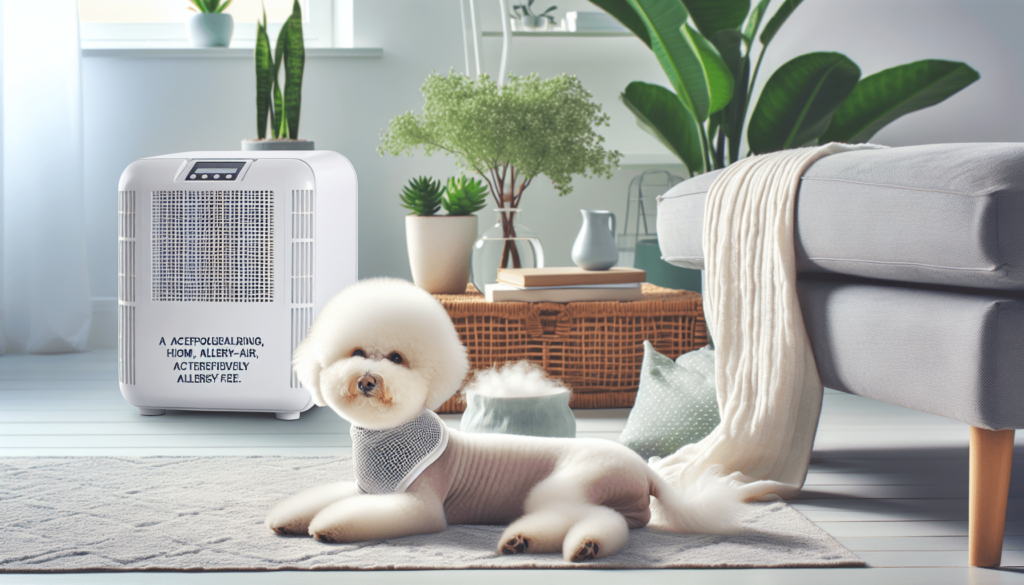Introducing a new pet to someone with allergies might seem challenging, but with a few thoughtful steps, you can make it a joyful experience for both the pet and the allergy-sensitive person. First, it’s important to select a hypoallergenic breed or an animal less likely to trigger reactions. Gradually increase the time spent together to give the person’s immune system a chance to adjust. Maintain a clean environment by regularly grooming the pet and keeping the living areas free of dander. With patience and care, you can create a harmonious home where both the person and the pet thrive. Have you ever wondered how you can introduce a pet to someone who is sensitive to allergies?
Tips for Introducing a Pet to an Allergy-Sensitive Person
Having a pet can bring immense joy and companionship into one’s life. However, for many, the thought of pet dander and allergies can make this prospect a bit daunting. With a bit of preparation and knowledge, you can make this transition smoother and more comfortable. Here are some tips to help you introduce a pet to an allergy-sensitive person.

Understanding Pet Allergies
Before diving into the tips, it’s important to understand what pet allergies are and how they work. Many assume that pet allergies are caused by an animal’s fur, but it’s often due to proteins found in a pet’s dander, saliva, and urine.
Common Symptoms of Pet Allergies
When someone is allergic to pets, their immune system reacts to harmless proteins as if they are threats. This can lead to a variety of symptoms:
- Sneezing and Runny Nose: One of the most common signs of pet allergies.
- Itchy, Watery Eyes: Often accompanied by redness.
- Nasal Congestion: Blocked or stuffy nose.
- Coughing and Wheezing: Especially in individuals with asthma.
Testing for Pet Allergies
If you suspect someone has a pet allergy, it’s a good idea to consult an allergist. They may recommend:
- Skin Prick Test: Small amounts of allergens are introduced to the skin.
- Blood Test: Measures the IgE antibodies in response to pet allergens.
Understanding the exact nature of the allergy can help you manage and mitigate reactions more effectively.
Choosing the Right Pet
Not every pet will trigger an allergic reaction in an allergy-sensitive individual. Some animals are considered more hypoallergenic than others, making them better companions for those with allergies.
Hypoallergenic Pet Breeds
While no animal is truly hypoallergenic, certain breeds produce fewer allergens and are often better suited for allergy-sensitive individuals.
| Hypoallergenic Dogs | Hypoallergenic Cats |
|---|---|
| Poodle | Sphynx |
| Bichon Frise | Balinese |
| Portuguese Water Dog | Russian Blue |
| Schnauzer | Devon Rex |
Other Pet Options
In addition to dogs and cats, consider other pets that may not cause as many allergic reactions:
- Fish: Require minimal handling and produce no dander.
- Reptiles: Such as geckos or snakes, which do not have fur or dander.
- Birds: Can be an option, but their feathers and droppings may still cause reactions in some people.
Preparing Your Home
Introducing a pet into an allergy-sensitive household requires some preparation. Making changes to your living space can help reduce allergen levels and create a more comfortable environment.
Cleaning and Decluttering
Regular cleaning can reduce the number of allergens in your home. Consider the following tips:
- Vacuum Frequently: Use a vacuum with a HEPA filter to effectively trap allergens.
- Wash Bedding and Upholstery: Regularly wash items that can trap pet dander.
- Declutter: Remove unnecessary items that can collect dust and dander.
Creating Pet-Free Zones
Designate certain areas of your home as pet-free zones, especially bedrooms. This gives the allergy-sensitive person a safe space to retreat to if symptoms flare up.
Air Purification
Investing in an air purifier with a HEPA filter can greatly reduce airborne allergens. Place the purifier in rooms where the pet spends the most time.
Managing Allergies When You Have a Pet
Even with the best preparations, there might be times when allergies flare up. Managing these reactions effectively is key to ensuring a harmonious coexistence.
Grooming and Bathing Your Pet
Regular grooming and bathing can minimize the amount of dander your pet produces.
- Frequent Bathing: Aim to bathe your pet weekly using a gentle pet shampoo.
- Daily Brushing: Regular brushing can reduce shedding and dander. For people with severe allergies, consider having a non-allergic person do the grooming.
Personal Hygiene
Encouraging good personal hygiene can help in managing allergens:
- Hand Washing: Wash your hands after playing with or touching your pet.
- Changing Clothes: After pet interaction, change your clothing to minimize allergen transfer.

Medical Interventions
Sometimes, despite all efforts, medical interventions may be necessary to manage allergies effectively.
Over-the-Counter Medications
Several medications can help manage allergy symptoms:
- Antihistamines: Such as cetirizine or loratadine to relieve sneezing and runny nose.
- Nasal Sprays: Can help reduce inflammation and congestion.
- Decongestants: To alleviate nasal congestion.
Prescription Options
For more severe allergies, a doctor may prescribe:
- Stronger Antihistamines or Nasal Sprays: Tailored for specific symptoms.
- Immunotherapy: Allergy shots that gradually desensitize the immune system to pet allergens.
Creating Positive Pet Interactions
Building a positive relationship between the allergy-sensitive person and the new pet is crucial. Take steps to ensure meetings are pleasant and stress-free.
Gradual Introduction
Start with short, controlled interactions:
- Short Visits: Begin with brief meetings and gradually increase duration.
- Safe Distance: Maintain a comfortable distance initially and gradually reduce it as the person adapts.
Positive Reinforcement
Reward both the pet and the allergy-sensitive person for calm, positive behavior:
- Treats for the Pet: Reinforce calm behavior by rewarding your pet with treats.
- Encouragement for the Person: Offer encouragement and praise to the allergy-sensitive person to create a more positive experience.
Monitoring Reactions
Keep a close eye on any symptoms that might arise during interactions:
- Keep a Diary: Record the duration of interactions and any symptoms that occur.
- Adjust as Needed: If symptoms worsen, reduce exposure time and revisit other allergy management strategies.
Long-term Strategies for Allergy Management
Once the pet is comfortable in the home and initial allergies are under control, consider long-term strategies to maintain a harmonious living environment.
Allergen-Reducing Products
Several products are designed to reduce allergens and can be incorporated into your daily routine:
- Allergen-Reducing Pet Shampoos: Use regularly to minimize dander production.
- Anti-Dander Sprays: Apply on your pet between baths.
Regular Veterinary Checkups
Ensure your pet is healthy and well-groomed with regular veterinary visits. A healthy pet often produces fewer allergens.
Home Environment Upkeep
Maintaining a clean, allergen-reduced home environment is a continuous process:
- Ongoing Cleaning: Keep up with regular cleaning schedules.
- Monitor Air Quality: Continue using air purifiers and keep windows open when weather permits.
Consistent Routine
Establish a consistent routine for both the pet and the allergy-sensitive person. Predictability and routine can reduce stress and help in managing allergies more effectively.
Finding Support and Resources
It’s important to seek support and resources when managing pet allergies. Knowing you’re not alone can make a significant difference.
Seek Professional Advice
If managing allergies becomes challenging, don’t hesitate to consult professionals:
- Allergists: Can provide tailored advice and medical solutions.
- Veterinarians: Can offer tips on keeping your pet clean and healthy.
Join Allergy Support Groups
Connecting with others who are going through similar experiences can provide emotional support and practical advice:
- Online Forums: Participate in discussions and share tips.
- Local Groups: Attend meetings and events to meet others in your community.
Educational Resources
Stay informed by reading up on pet allergies and management strategies:
- Books and Articles: Numerous resources are available to offer guidance.
- Webinars and Workshops: Participate in events hosted by allergy specialists.
Embracing Your Allergy-Sensitive Lifestyle
Adjusting to life with a pet and an allergy-sensitive household member can be challenging but also rewarding. Embrace the journey and enjoy the many benefits pets bring to your life.
Celebrate Small Wins
Remember to celebrate the small victories along the way:
- Symptom-Free Days: Acknowledge and celebrate days when allergies are well-managed.
- Successful Interactions: Recognize progress in building a positive relationship between the person and the pet.
Building a Strong Bond
Despite the challenges, building a strong bond with your pet can bring immense joy:
- Quality Time Together: Spend time together playing, walking, or just relaxing.
- Training Sessions: Engage in positive training sessions to enhance your pet’s behavior and your bond.
Enjoying the Benefits of Pet Ownership
Pets offer numerous benefits that far outweigh the challenges:
- Emotional Support: Pets can offer unconditional love and companionship.
- Stress Relief: Interacting with pets is known to reduce stress and anxiety levels.
- Active Lifestyle: Owning a pet often encourages a more active and engaged lifestyle.
Conclusion
Introducing a pet to an allergy-sensitive person requires thoughtful preparation and ongoing management. By understanding pet allergies, choosing the right pet, preparing your home, managing allergies effectively, and creating positive interactions, you can enjoy the companionship of a pet while minimizing allergic reactions.
Remember to seek support and resources, celebrate small wins, and embrace the journey. With these tips and a positive approach, you can create a harmonious and fulfilling relationship with your new pet, ensuring that both the allergy-sensitive person and the pet thrive together.
